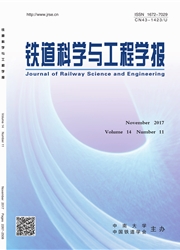

 中文摘要:
中文摘要:
将空气流场视为黏性、可压缩的非定常流,对高速列车和跨线桥梁模型进行适当简化,以沪昆线上某(112+80+32)m预应力混凝土独塔斜拉桥为例,基于大型计算流体力学软件Fluent,采用滑移网格法建立高速列车和跨线斜拉桥流场计算模型。分析了列车以350km/h速度从斜交跨线斜拉桥下穿过时,桥梁底面压强分布情况。通过积分换算出列车气动效应对桥梁产生升力、阻力和扭矩时程。将该气动力时程施加至斜拉桥空间动力模型,研究运营阶段斜拉桥动力响应。研究表明,高速列车尾流对斜拉桥的气动力作用大于列车头,列车正上方梁体所受气动力最大;列车风对运营阶段斜拉桥影响极小,可忽略不计;若跨线桥为质量惯性较小的钢桥,列车气动力对其影响仍需进行相应研究。
 英文摘要:
英文摘要:
The model of high speed train and overpass cable - stayed bridge was simplified by regarding the air flow field as a viscous, compressible unsteady flow. Based on large - scale computational fluid dynamics software Fluent, the sliding mesh method was used to establish the calculation model for high - speed train and overpass cable -stayed bridge flow field by taking a (112 plus 80 plus 32 ) m prestressed concrete cable -stayed bridge with single tower on the Shanghai--Kunming line as an example. When the train was passing under the skew o- verpass cable - stayed bridge at 350 km/h speed, pressure distribution at the bottom of bridge was analyzed. The integral was converted to the lift force, resistance and torque time history of the bridge generated by train aerody- namic effect. Dynamic response of cable - stayed bridge was studied at operation stage by applying the aerody- namic time history to spatial dynamic model for the cable - stayed bridge. Research shows that aerodynamic effect of the high -- speed train tail flow on the cable - stayed bridge is greater than the train head, and the aero- dynamic force imposed to the beam just above the train is of the maximum. The impact of train wind on cable - stayed bridge is minimal at the operation stage, which can be negligible. If the overpass bridge is a steel bridge with the smaller inertia mass, train aerodynamic effect on it is still necessary to do the corresponding research.
 同期刊论文项目
同期刊论文项目
 同项目期刊论文
同项目期刊论文
 期刊信息
期刊信息
